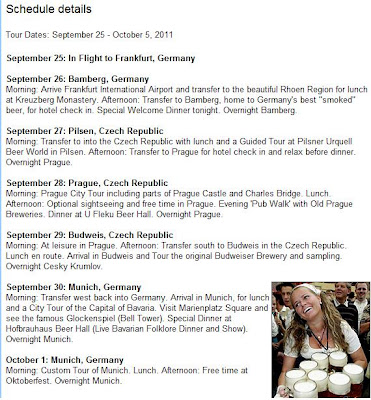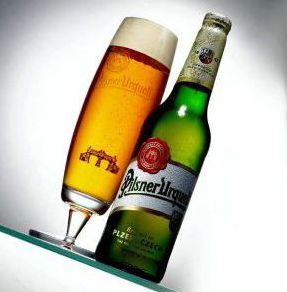Theming
Oktoberfest Restaurants
Restaurants are themed to Oktoberfest, and claim to sell ‘Oktoberfest’ food and beer. However, the beer produced for Oktoberfest alone, is only distributed in Munich, at the actually Oktoberfest.
Oktoberfest Tours
Travel agents have also noticed that large amounts of tourists are visiting Germany because of Oktoberfest. Using that advantage, they themed their tours as Oktoberfest, hoping to increase visitorship and revenue. However, having looked at the itinerary, it is merely a beer tasting tour in Europe. Having it themed with the word Oktoberfest just promotes the image of the tour.
Oktoberfest Games
Games are also themed according to Oktoberfest. For instance, they have beer serving games, to setting up the Oktoberfest event, and even violent games like Oktoberfest Runescape. Teenagers are now playing Oktoberfest games just like any ordinary games, and sooner or later, they will either get sick of it or get addicted to it. And in both ways, Oktoberfest would be remembered as “boring” or as an addicting game. It will no longer be remembered as Prince Ludwig and Princess Therese’s marriage.
The same goes for other themed activities. Even though theming uses the same name of Oktoberfest, the end products are still new forms of products, and the whole idea is to maximise profits. This would obviously lead to a loss of authenticity in the festival because producers will shape the products to meet their demands.
Dedifferentiation of consumption
“Whether you believe it or not, but a lot of visitors actually don't visit the Oktoberfest for the beer but for the many, many other attractions like the amusement rides, the roller coasters and their countless varieties.” (About the Oktoberfest, 2010) It is getting more and more unclear of what the real Oktoberfest product consist of. In the past, there were no amusement rides, but the rides are actually the pull-factors for some to attend Oktoberfest.
Pictures of the rides:
Looking at these photos, it is difficult to tell that it is actually Oktoberfest.
Also, Oktoberfest is being so commercialised that they now use horses as advertising platforms. The horses were once used to transport people.
These changes made to Oktoberfest create a blurring line between its true form and its current form.
Merchandising
From costumes to jewelleries to the mugs used in Oktoberfest, they can be purchased from the festival or the Oktoberfest website.
Yes, these merchandise does reminds people about Oktoberfest when they are back home. However, this means that Oktoberfest is not unique to Germany anymore since the merchandise can be found everywhere in the world, in somebody’s house.
Emotional labour
Beer girls have to show their cleavage and put on a demure look even though they are caring heavy mugs. There is also a need to portray that they are sexy. This might bring about psychological conflict between what the girls have to portray and also what they really want to be. They might even be discriminated for who they are faking due to work.
Using Oktoberfest as example, I will analyse the changes as a whole that have been brought about by the growth of tourism in the country. With the huge amount of demand, supply tries to meet the needs of the demand and shape the product to best suit the demand. Henceforth, amusement parks, retail, games, and merchandise are all being integrated into Oktoberfest. This integration modifies the entire festival, making it into another festival that has eroding distinctive taste.
Yes, it has brought about “approximately 830 Millions EURO during the 16 days are spent - 324 Mio EURO on the festival grounds for food, drinks and entertainment, 205 Mio EUR0 for shopping in and around Munich, public transport and restaurants as well as about 301 Mio EURO for hotel accomodation. About 12,000 people are employed to enable the world´s largest and most popular festival.”
However, with such large influx of tourists, we question: is Oktoberfest Staged? How authentic is it? How much of it has been modified to suit tourists demands? Are the Germans welcoming tourists? Will they still welcome tourists in the future? There is always a limit to everything. According to Doxey’s Irridex, it will eventually lead to the stage of antagonism, where irritation is openly displayed by the Germans towards the tourists.
Has tourism been a culprit in commodifying cultures and traditions?
In my opinion, tourism has been a culprit in commodifying cultures and traditions to a small extent.
Globalisation is the culprit in commodifying cultures and traditions.
This is because globalisation has sped up technological advancements, improved communication tools, and brought about better transportation at a rapid speed.
Humans are greedy by nature, and love to seek new things. With such constant changes in the world, there is no time for clear evaluation of the pros and cons of sticking with the old or carrying on with the new.
Globalization has blinded the world as what people care about is to keep up with the world. All these will eventually further commodify cultures and traditions.
On the other hand, tourism also plays a part in commodifying cultures and traditions. This is as tourists get to meet the hosts in their destinations on a face-to-face circumstance. It is also human’s nature to want to be as one with the world. This face-to-face interaction allows sharing of cultures and adaptations of each other’s lifestyles. That will also commodify cultures and traditions.
However, without globalization, tourism would not be such a huge market. A smaller market of tourism will not be as impactful in commodifying cultures and traditions. Therefore, as globalization has significantly boosted the tourism industry, globalisation is the culprit in commodifying cultures and traditions.
Globalization has blinded the world as what people care about is to keep up with the world. It is only through contentment and appreciation of what we have in the present times, can we prevent such homogenization of cultures and traditions from happening.
Bibliography:
About the Oktoberfest. (2010). Retrieved 10 December, 2010, from The Oktoberfest Website: http://www.oktoberfest.de/en/article/About+the+Oktoberfest/About+the+Oktoberfest/Fun+Rides,+Carousels+and+Shows/821/
Munich tourist office. (2010). Interesting Facts and Figures. Retrieved 10 December, 2010, from http://www.muenchen.de/Rathaus/tourist_office/oktobfest/126031/oktoberfest_Zahlen_Statistiken.html




















